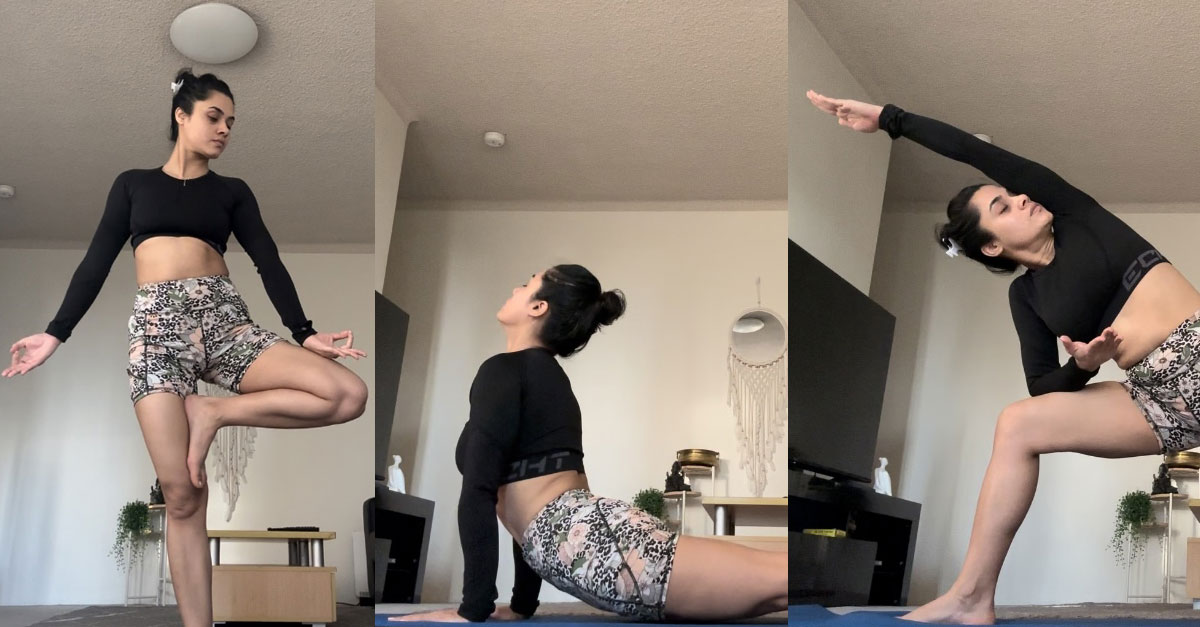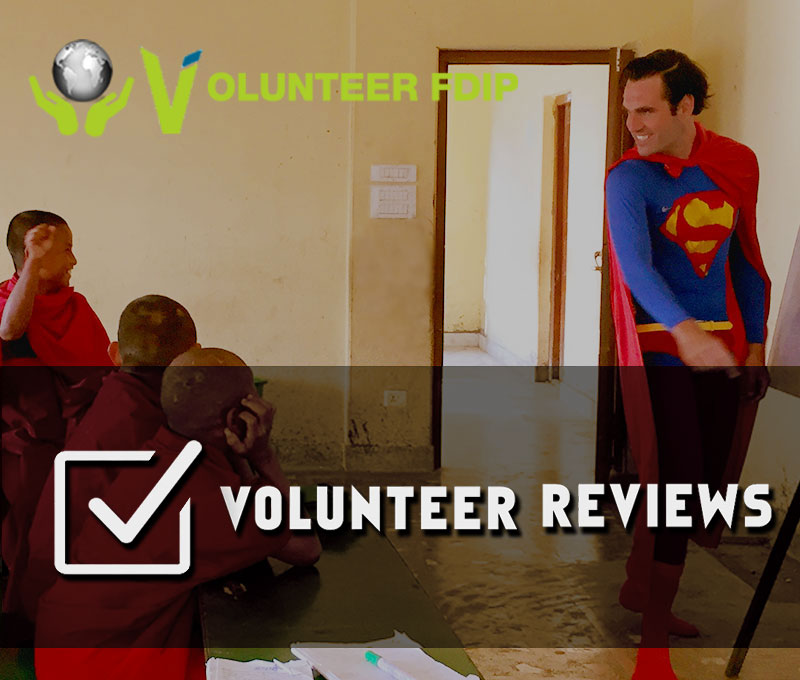Best Yoga Positions for Beginners: 16 Asanas by a Yoga Enthusiast from Sydney
By: Barsha Gautam
TweetA variety of positions in yoga, also known as asanas, are commonly encountered by both beginners and experienced yogis. Familiarize yourself with 16 fundamental yoga postures, their names, and their associated benefits. You will also acquire the knowledge needed to execute these yoga positions accurately, enabling their incorporation into your personal yoga practice.
Are you a beginner trying to embark into the experience of yoga and meditation? Explore these yoga positions that I have enlisted and suggested for you. Before starting my journey as a yoga enthusiast, I tried these positions. Practicing them has helped me a lot to build my foundation for yoga and practicing yoga regularly helped me relieve myself from my hectic schedules in Sydney and pursue a healthy and fit life.
Please click here to get the complete details on available programs, activities, duration, cost, benefits and the rest of it.
Get More Info Now »
The Mountain Position (Tadasana)
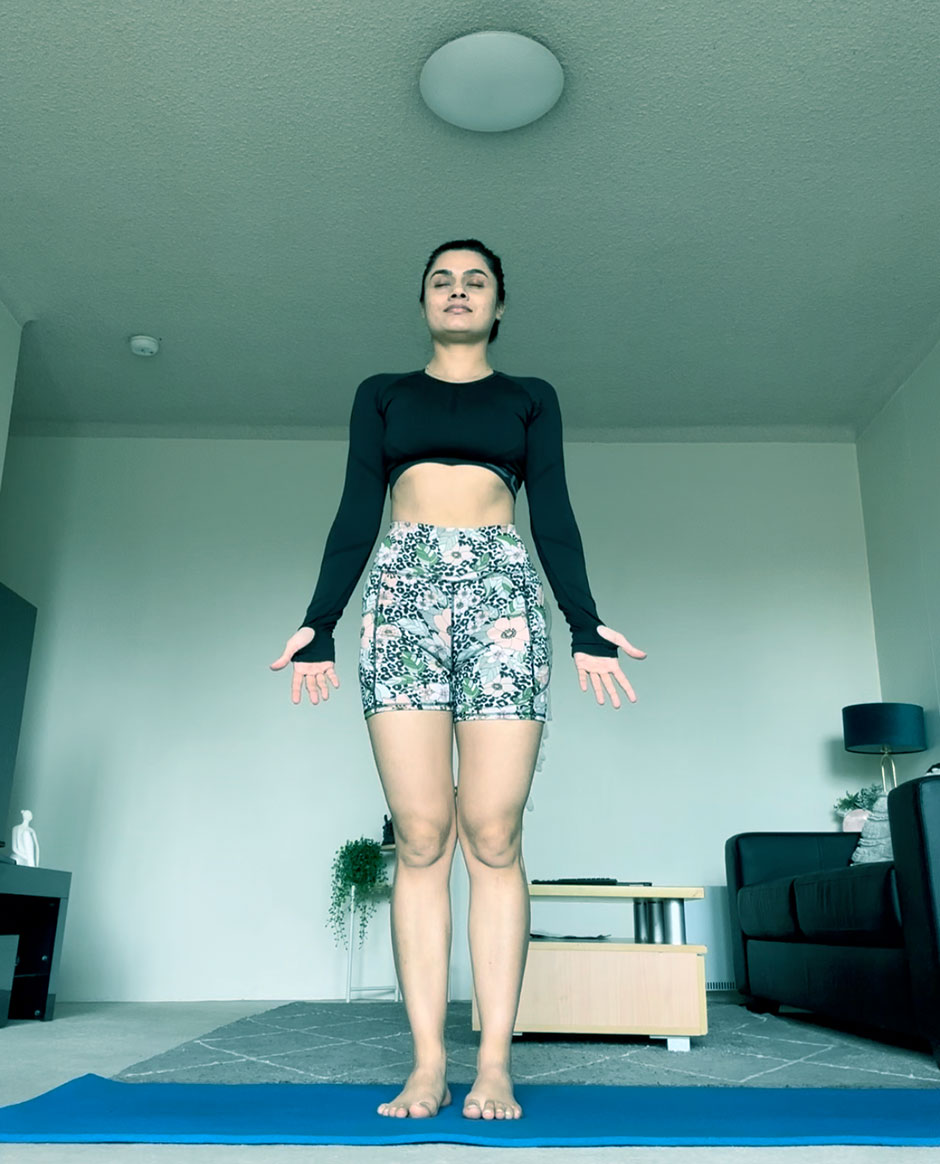
Photo: Mountain Pose Front Facing
The Mountain Pose (Tadasana) is a classic standing pose in yoga that conveys stability. It has several beneficial effects, including the improvement of posture and the strengthening of the legs.
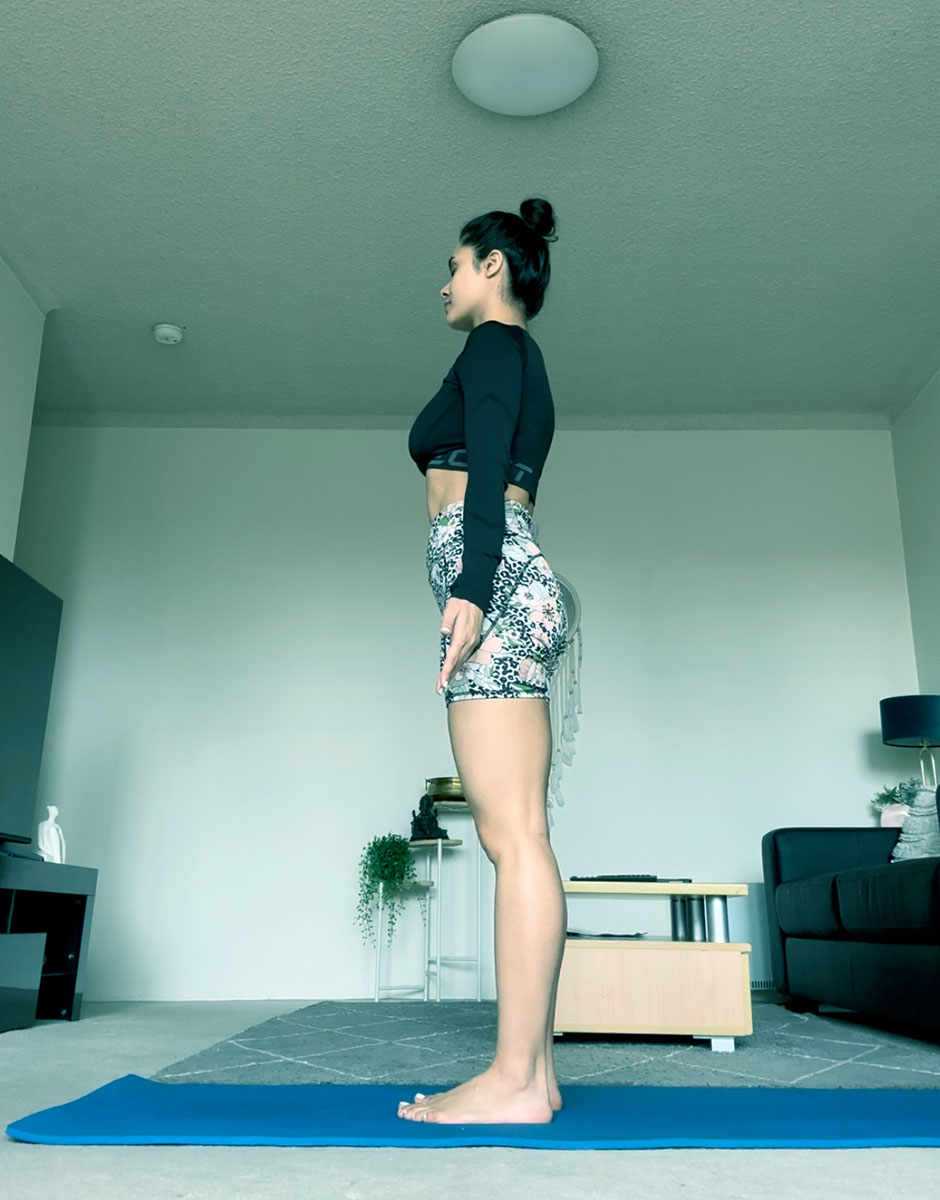
Photo: Mountain Pose Side Facing
To perform the Mountain Pose, begin by standing up straight with your big toes touching and your heels slightly apart. Alternatively, you can place your feet hip-width apart for balance. Make sure to distribute your weight evenly between both feet. Engage your thighs, straighten your kneecaps forward, and rotate your thighs slightly inward. Let your arms hang loosely down, with your palms resting on the sides of your thighs. Ensure that your shoulders sink down and raise your breastbone towards the ceiling. Hold this position for 30 seconds to fully experience its benefits.
Chair Position (Utkatasana)
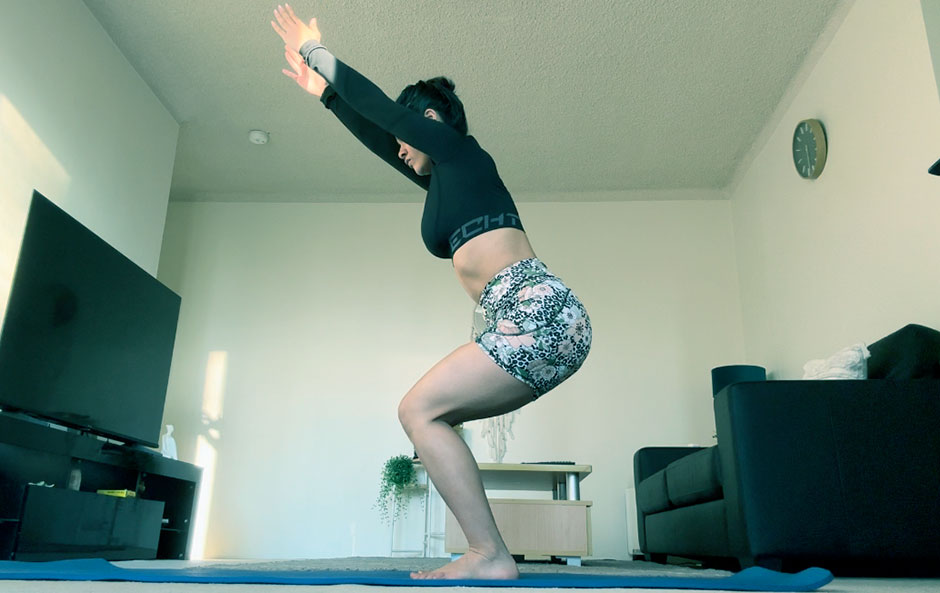
Photo: Chair Position (Utkatasana)
Chair Pose (Utkatasana) is a standing yoga posture often practiced immediately after the Mountain Pose. This pose provides several benefits, including the strengthening of the thighs, ankles, and calves. It's particularly effective in activating the core muscles, which contribute to improved posture and stability. To perform the Chair Pose, begin in the Mountain Pose, firmly grounding your feet. As you inhale, raise your arms straight up. On the next inhalation, gradually bend your legs into a squatting position, ensuring they remain parallel and your buttocks draw towards your heels. Simultaneously, your torso should lean forward, forming approximately a right angle with your thighs. It's essential to extend your tailbone downward and lengthen your lower back for proper alignment.
Incorporating Utkatasana into your yoga practice can help enhance lower body strength and overall stability while engaging your core muscles for a well-rounded workout. This asana not only contributes to physical well-being but also promotes mindfulness and concentration as you hold the pose and maintain steady breath. Chair Pose, with its profound effects on the body and mind, is a valuable addition to any yoga routine, offering a balanced blend of strength and tranquility.
Please click here to get the complete details on available programs, activities, duration, cost, benefits and the rest of it.
Get More Info Now »
Standing Forward Bend Pose (Uttanasana)
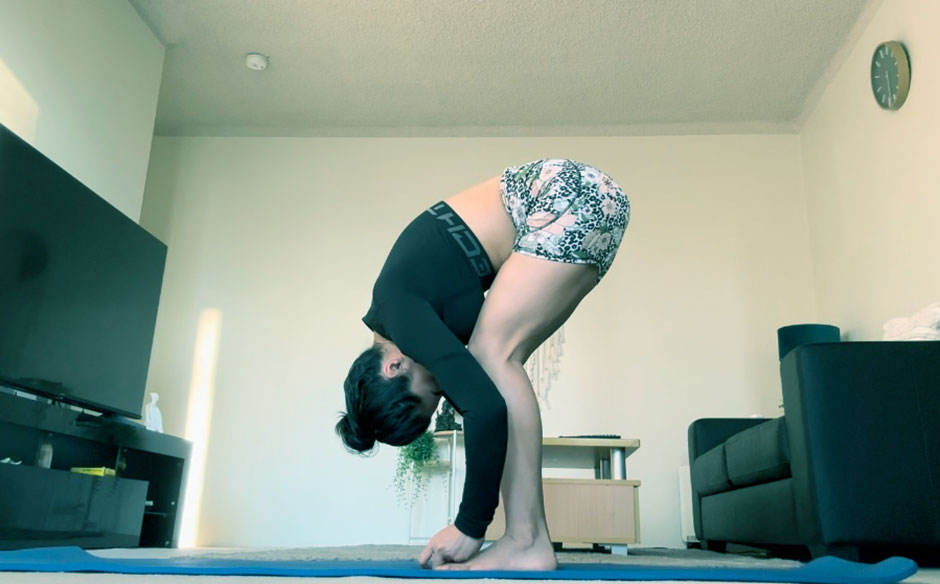
Photo: Standing Forward Bend Pose (Uttanasana)
Standing Forward Bend Pose (Uttanasana) may seem simple, but correct technique and execution are crucial for this yoga position. Its effects include stretching the backs of the legs, strengthening the thighs and knees, relaxing the shoulders and neck, and mobilizing the hip joints. To perform this pose, start in Mountain Pose with your feet firmly planted on the ground. Exhale and bend forward from your hips.
With each subsequent exhale, lengthen the front of your torso further. Keep your legs as straight as possible, but if you're less flexible, it's acceptable to keep your knees slightly bent. Allow your arms to hang down, placing your hands on the mat, or alternatively, you can grasp your elbows or ankles with your hands. Ensure that your torso remains as straight and long as possible, prioritizing this over bending as far as you can. Let your head hang loosely, keeping the neck relaxed, and keep the shoulders away from the ears. After holding the forward bend for about 30 seconds, gradually straighten up, one vertebra at a time, returning to Mountain Pose to pause for a moment.
Child's Position (Balasana)
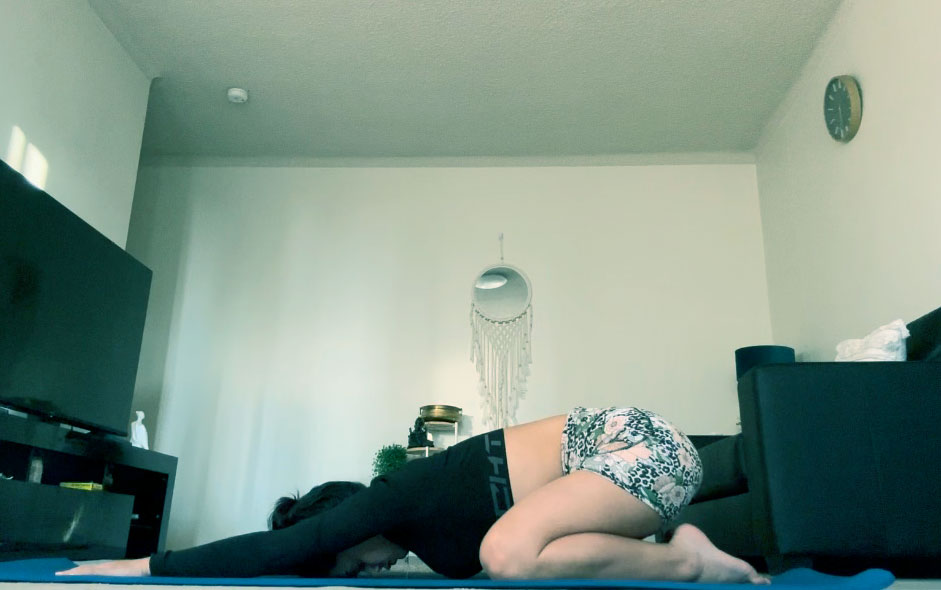
Photo: Child's Position (Balasana)
Child's Pose (Balasana) is a commonly encountered yoga position, ideal for beginners and experienced practitioners alike. This relaxing posture offers multiple benefits, including gentle thigh and ankle stretching, hip joint mobilization, lower back tension relief, and a soothing effect on the mind. To perform it, kneel on your yoga mat, with knees either close together or spread in a V-shape. Exhale as your upper body gently descends forward, forehead resting on the mat. Extend your arms parallel to your thighs, palms facing up, and relax your shoulders while consciously breathing into the back of your body. Hold Child's Pose for 30 seconds or longer for its calming and rejuvenating effects.
Child's Pose is a versatile, restorative yoga position useful for relaxation and renewal during your practice. Its simplicity and effectiveness make it a yoga staple, offering both physical relief and mental sanctuary. Whether you're a beginner or an experienced yogi, incorporating Balasana into your practice provides valuable moments of tranquility and release.
Tabletop Position (Bharmanasana)
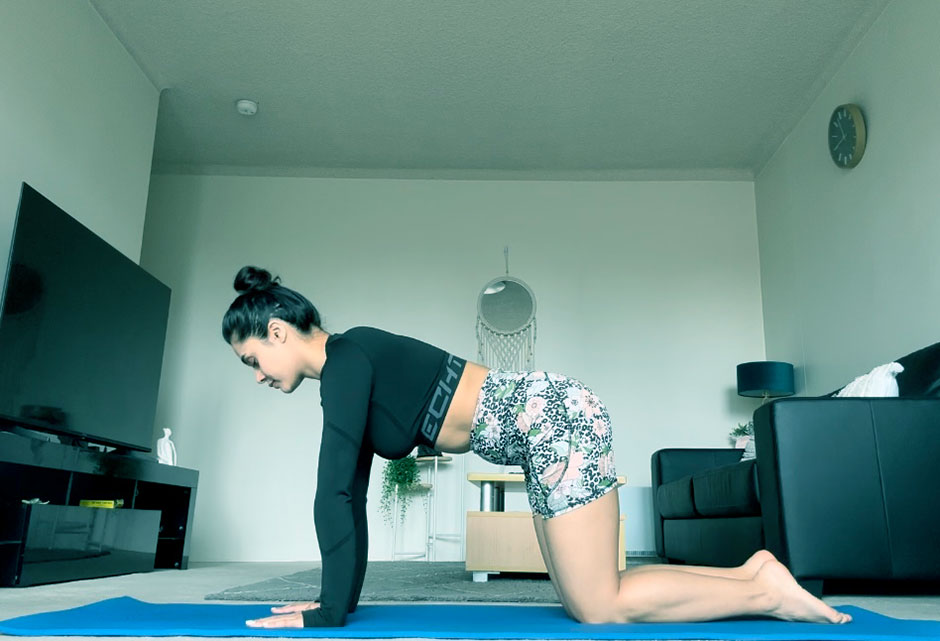
Photo: Tabletop Position (Bharmanasana)
Tabletop Pose (Bharmanasana) is a foundational yoga position that serves as the starting point for various exercises. Its primary effect is the strengthening of the supporting core muscles. To perform this pose, come down onto the mat with your knees and hands, ensuring that your wrists are under your shoulders and your knees are under your hips. Keep your insteps flat on the floor and your knees hip-width apart, creating a straight line with your back. Your neck should be an extension of your spine, and your gaze should be directed downward to the mat.
Please click here to get the complete details on available programs, activities, duration, cost, benefits and the rest of it.
Get More Info Now »
Tabletop Pose provides stability and serves as a fundamental building block for many yoga sequences. It helps enhance core strength, making it an essential posture for practitioners of all levels. By incorporating Bharmanasana into your practice, you can improve your posture, balance, and overall yoga experience.
Cat - Cow Position (Chakravakasana)
Cat - Cow Pose (Chakravakasana) is a yoga posture that involves a fluid movement between two distinct positions: the "cat" (Marjaryasana) and the "cow" (Bitilasana). This dynamic duo of poses is often interconnected to mobilize the spine and serve as an excellent introduction to a yoga session. The cat phase features a rounded back, resembling a cat stretching itself, with an exhalation that initiates the movement, starting from the pelvis and drawing the belly button towards the spine. In contrast, the cow phase entails gently arching the back into a hollow shape, lifting the head slightly forward as you inhale. Repeating this cat-cow flow several times while synchronizing your breath is key to deriving its benefits.
The primary effects of Cat-Cow Pose include the mobilization of the spine, enhancing flexibility, and promoting relaxation of the back muscles. By transitioning between these two positions, practitioners can experience an improved sense of body awareness and breath control. This posture helps create a gentle rhythm that prepares the body and mind for a yoga practice, making it a popular and well-suited warm-up exercise in yoga sessions of all levels.
Downward-Facing Dog Position (Adho Mukha Svanasana)
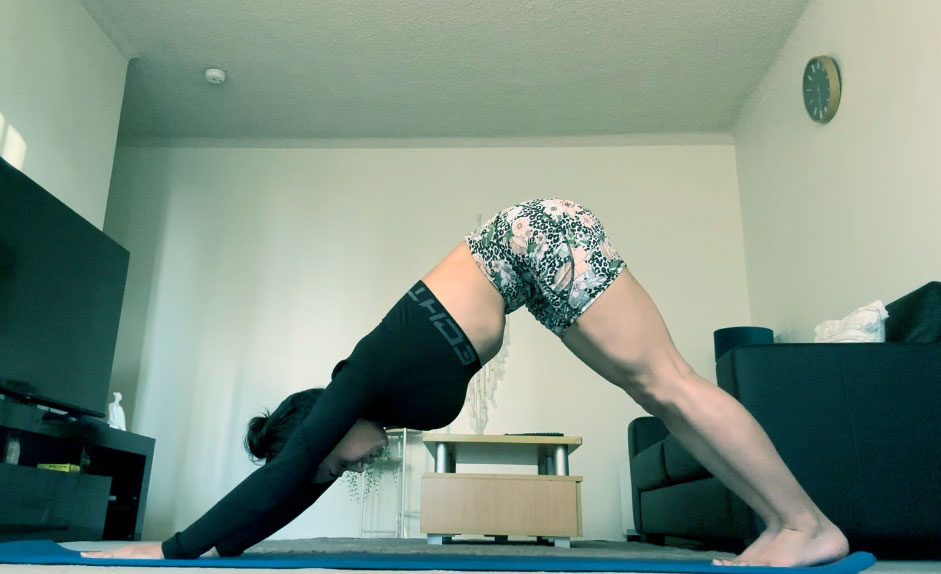
Photo: Downward-Facing Dog Position (Adho Mukha Svanasana)
Downward-Facing Dog Pose (Adho Mukha Svanasana) is a classic yoga posture used for balancing in yoga flow. It combines standing and inversion elements. This pose calms the mind, energizes the body, stretches the shoulders, hamstrings, and hands, and strengthens the arms and legs.
To perform it, start on all fours with hands under shoulders and knees under hips. Spread fingers evenly on the mat. Exhale to lift knees, push buttocks back, and lengthen the spine. Keep shoulders relaxed, head aligned with the spine, and gaze downward. Straighten legs and lower heels as far as comfortable. Hold for 30 seconds to a minute before transitioning to Child's Pose.
Upward Facing Dog Position (Urdhva Mukha Svanasana)
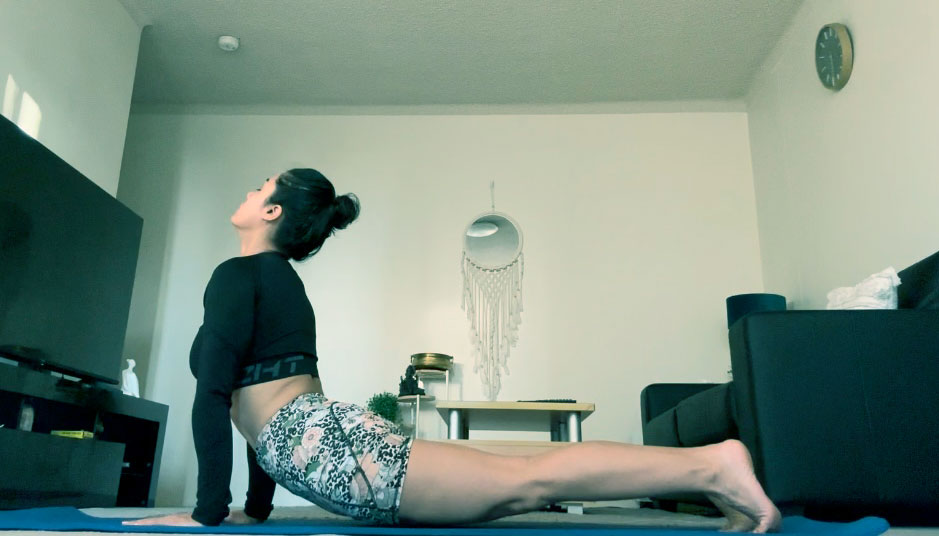
Photo: Upward Facing Dog Position (Urdhva Mukha Svanasana)
Upward Facing Dog (Urdhva Mukha Svanasana) is highly beneficial for those with sedentary jobs as it targets muscles often tense from prolonged sitting. This pose stretches the chest and shoulder muscles, strengthens the abdomen and leg muscles, and mobilizes the thoracic spine. To perform it, push the chest forward, draw the shoulders back, and stretch the legs and hips while bearing weight on the hands and the tops of the feet. Spread your fingers, slightly tilt your pelvis forward, keep your gaze toward the ceiling, and maintain a long neck.
Plank (Phalakasana)
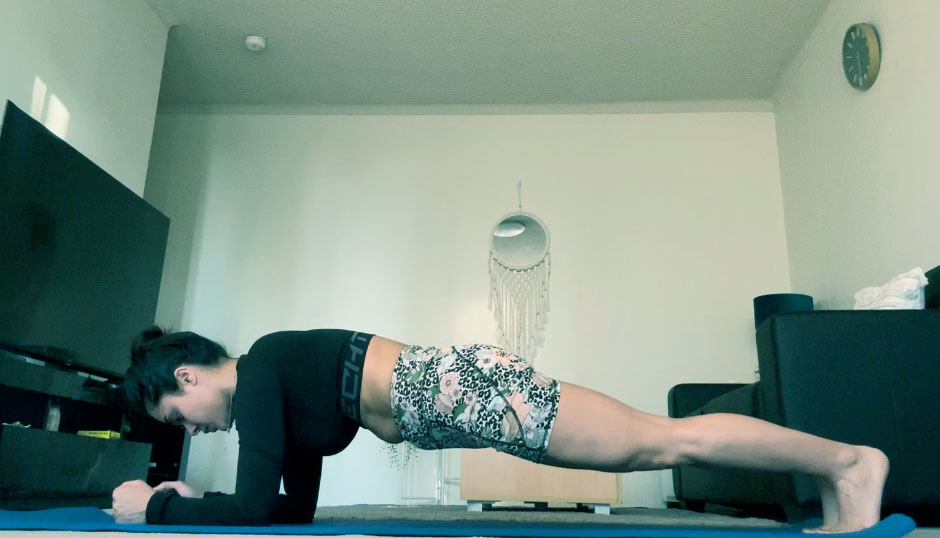
Photo: Plank (Phalakasana)
Plank (Phalakasana) is an arm-supported yoga position that is also referred to as the "plank" or "inclined plane," and it is typically practiced within the context of the downward-facing dog pose. This asana offers various benefits, including the strengthening of the shoulder girdle, arms, legs, and abdomen.
To perform this pose, begin in the Downward Facing Dog position. Inhale as you pull your torso forward, aligning your shoulders over your wrists while simultaneously lowering your pelvis. Your body should create a straight line, with your head in line with your spine as you gaze downward at the mat. Engage your buttocks and abdomen to create tension in your body, while your thighs reach towards the ceiling, and your coccyx maintains resistance. After holding the plank pose for approximately 30 seconds, transition back into the downward-facing dog position, and if needed, find relaxation in the child's pose.
Cobra Position (Bhujangasana)

Photo: Mountain Pose Side Facing
Cobra Pose (Bhujangasana) is a backbend yoga position commonly found in sequences like the classic sun salutation, a yoga practice comprising twelve asanas. This pose is effective for relaxing the back and preventing tension headaches and back strains.
The benefits of Cobra Pose include stretching the chest, shoulders, and abdomen while simultaneously strengthening the back. To execute this posture, start in the prone position, extending your legs with the tops of your feet gently pressing into the floor. Your hands should be positioned under your shoulders, with fingertips pointing forward. Gradually lift your upper body, including the head and chest, while inhaling. It's crucial not to use your hands to push yourself up; instead, rely on the strength of your core. Create length by moving your torso upward and forward rather than backward. Throughout the pose, ensure that your arms remain close to your body, and your shoulders are drawn back and down, opening your chest.
Tree Pose (Vrikshasana)
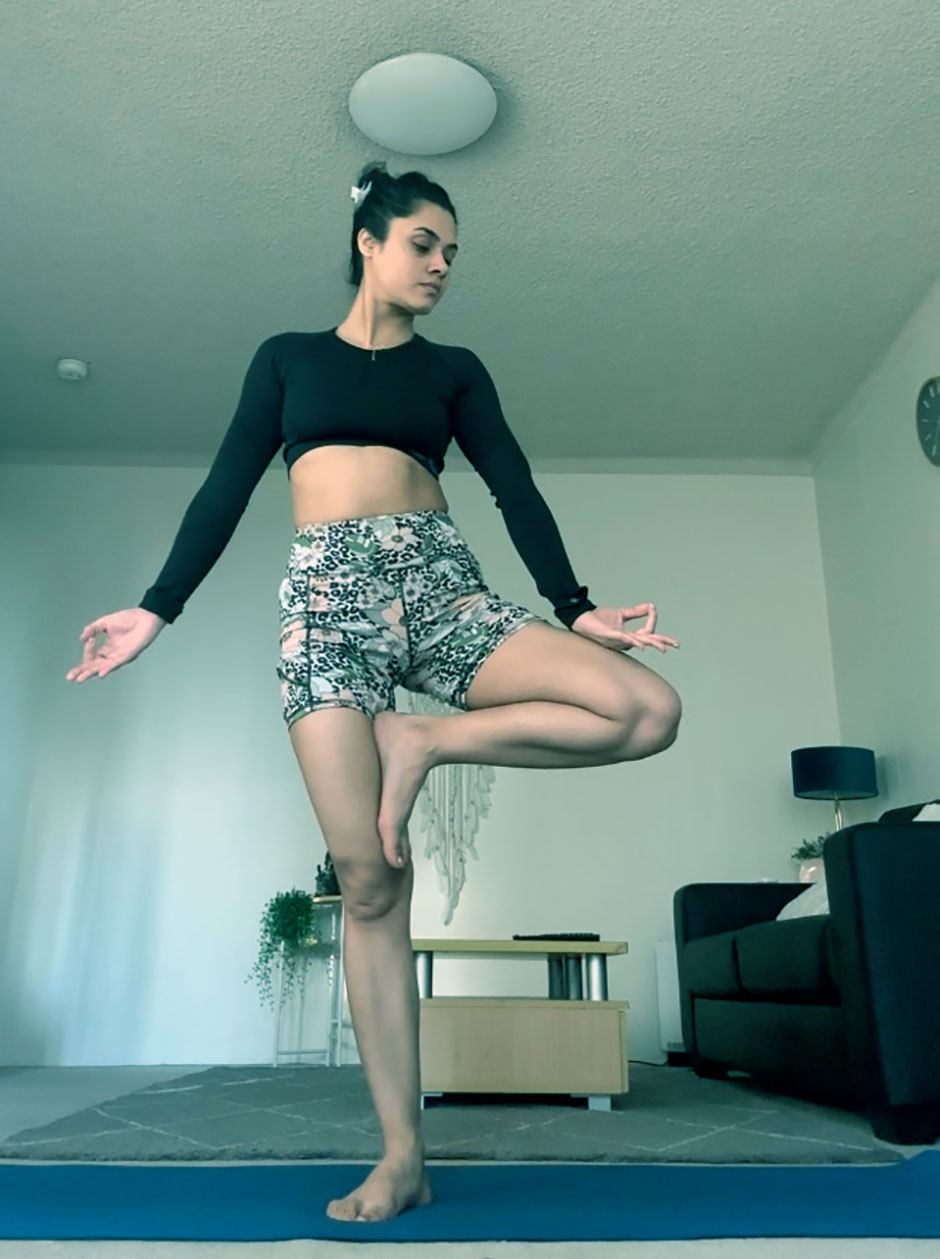
Photo: Tree Pose (Vrikshasana)
Tree Pose (Vrikshasana) is one of the most recognizable yoga positions, serving as a standing posture that enhances balance. Its effects include improving balance, strengthening the legs, and stretching the groins and thighs.
To perform this pose, start in Mountain Pose. Shift your weight to the right side, placing your right foot on the floor with a slightly bent knee. Lift your left foot, turn the knee outward, and rest the sole of your left foot on the inside of your right leg. Avoid placing your foot on the knee of your supporting leg. Maintain an upright posture, fix your gaze at one point and bring your palms together in front of your chest, or you can be creative by extending your arms on each side and balancing yourself with gyan mudra (holding tip of your thumb and index finger together). Hold for about 30 seconds, then switch sides.
Warrior Pose (Virabhadrasana)
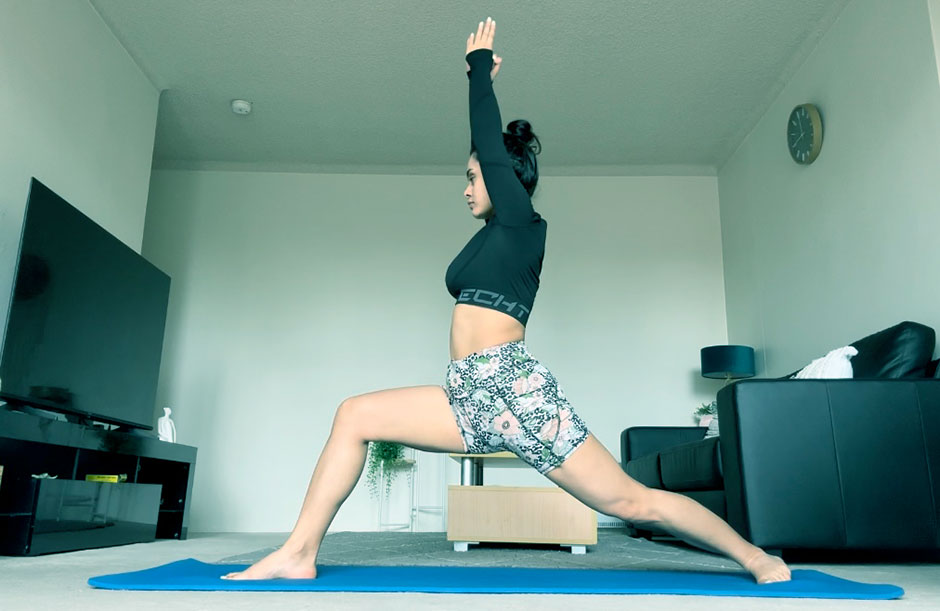
Photo: Warrior Pose (Virabhadrasana)
Warrior Pose (Virabhadrasana) is a series of five different yoga poses. It is sometimes referred to as the Hero Pose. This pose offers the effects of stretching the abdomen, legs, and groin while simultaneously strengthening the legs and back.
To perform this pose, start in the Mountain Pose. As you exhale, step your right foot back into a lunge, creating a leg-length distance from your left foot. Rotate your back foot outward at a 45-degree angle, with the front foot pointing forward and the heels in alignment. Maintain a shoulder-width stance with your feet, or for beginners, you can place them hip-width apart. Bend the knee of your left leg, ensuring it is positioned above the ankle. Your gaze should rise to your hands, while your chest lifts upward with a slight backward bend. Hold the Warrior pose for approximately 30 seconds.
Warrior II
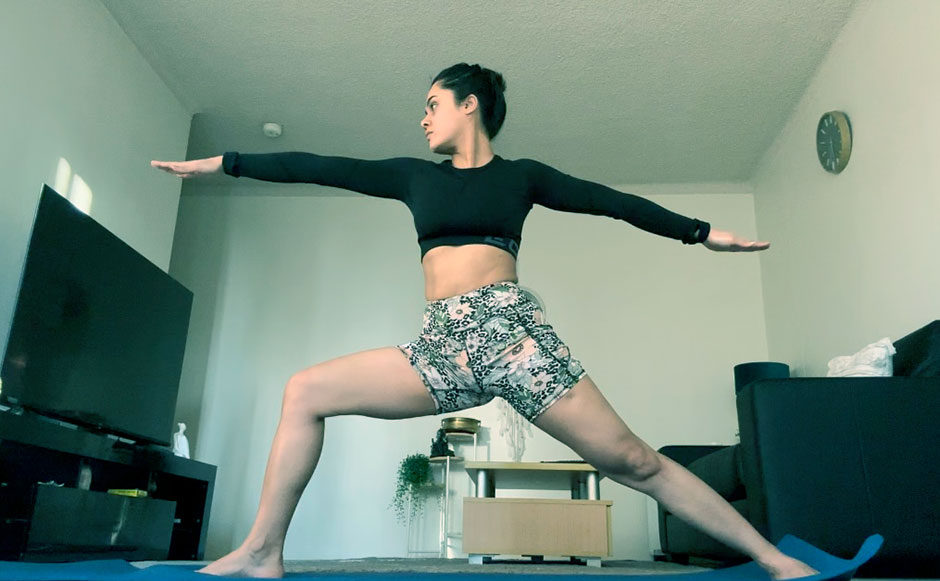
Reverse Warrior
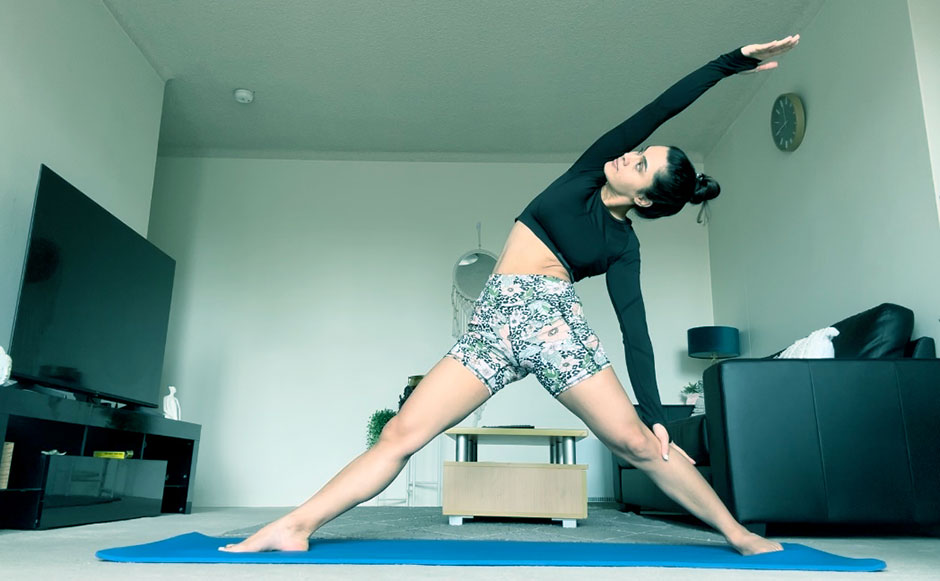
Triangle Position (Trikonasana)
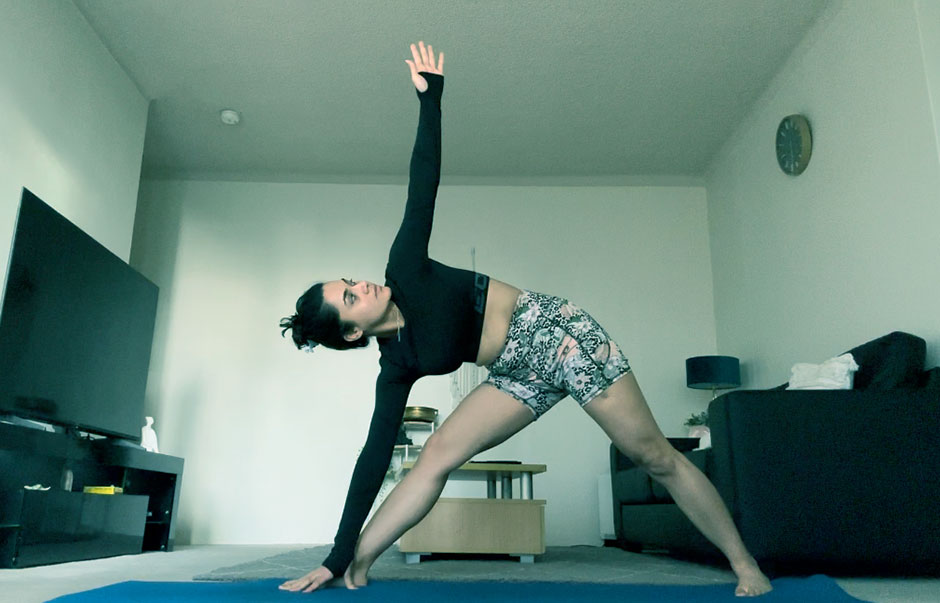
Photo: Triangle Position (Trikonasana)
Triangle Pose (Trikonasana) is a beginner-friendly standing yoga exercise in Hatha Yoga that combines stretching and relaxation. This asana involves a gentle stretch of the entire side of the body, opening the chest and massaging the internal organs. It strengthens muscles, including those in the lower back, abdomen, and buttocks. To perform this pose, start in a wide straddle stance with arms hanging down. Raise one arm above the head and stretch the body to the side. Focus on correct form and hold the stretch for 30-60 seconds, repeating it several times for optimal benefits.
Extended Side Angle Pose (Utthita Parsvakonasana)
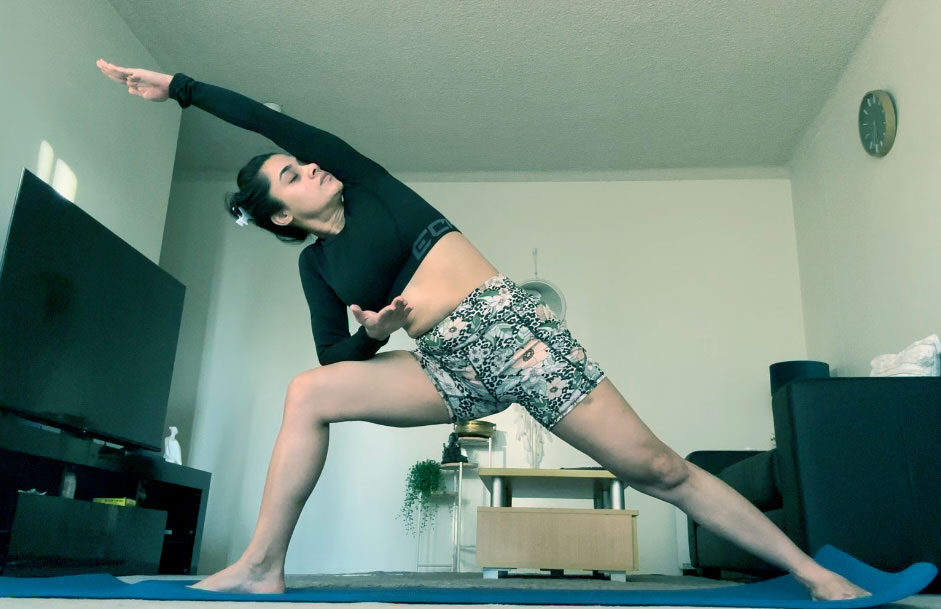
Photo: Extended Side Angle Pose (Utthita Parsvakonasana)
Please click here to get the complete details on available programs, activities, duration, cost, benefits and the rest of it.
Get More Info Now »
This is a yoga pose that enhances leg strength, lateral flexibility, balance, and stability. To perform it, sit with legs wide apart, stand firmly, and turn the left foot slightly inward while rotating the right foot outward at a 90-degree angle. Extend both arms parallel to the floor, bend the right leg to a right angle, and lean the upper body sideways over the right leg until the left arm touches the floor next to the foot. The left arm remains extended, and the gaze is directed upward. A block can be used for support if reaching the floor is challenging.
Bridge Pose (Setu Bandhasana)
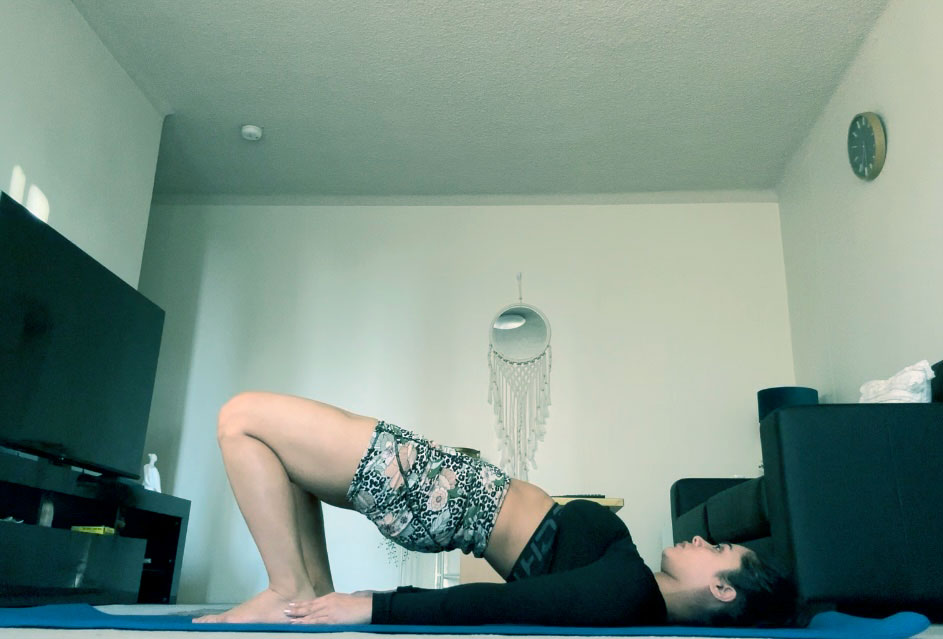
Photo: Bridge Pose (Setu Bandhasana)
Bridge Pose (Setu Bandhasana) is a supine backbend that opens and gently stretches the entire front of the body, particularly the chest and neck. This yoga pose is believed to alleviate stress and promote digestion by stimulating the internal organs. To perform this pose, start lying on your back with your arms stretched out at your sides. Place your feet hip-width apart and as close to your buttocks as possible, with the heels touching your sit bones if attainable. Exhale and press your feet firmly into the mat while lifting your pelvis, keeping the inner feet and thighs parallel.
You have two options for your arms in Bridge Pose. You can clasp your hands under your buttocks with arms straight, pressing your hands, shoulders, and feet into the mat to raise your pelvis higher. Alternatively, keep your arms close to your body on the mat with palms facing down. Squeeze your shoulder blades together and press your hands and shoulders firmly into the floor to elevate your pelvis further. Maintain a long and relaxed neck, keeping the back of your head centered. Avoid letting your knees fall apart by pressing your big toes firmly into the mat. After approximately 30 seconds in the shoulder bridge, lift your heels, place your arms at your sides, and slowly roll your back down to the floor, one vertebra at a time.
The Twist Seat Position (Ardha Matsyendrasana)
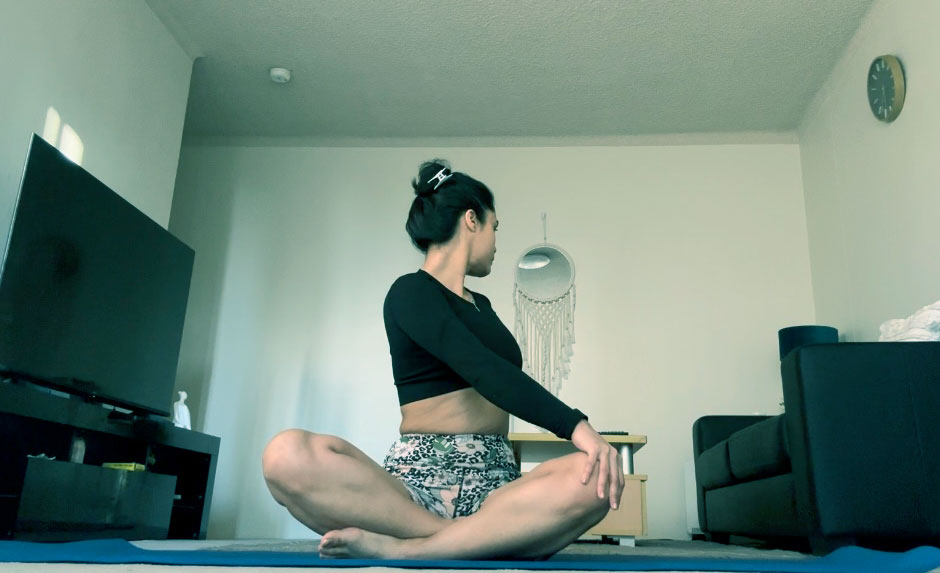
Photo: The Twist Seat Position (Ardha Matsyendrasana)
The Twist Seat, Ardha Matsyendrasana, effectively massages abdominal organs, aids digestion, and relieves flatulence and abdominal discomfort. This pose also alleviates back pain and upper body tension. Begin by sitting on your heels, placing your right foot next to your left buttock, and lifting your left foot to the right knee. Extend your right arm behind your back and hold the left ankle with the left hand, gently applying upper body pressure and twisting comfortably. Hold for 30-60 seconds, then switch sides.
In a Nutshell: Best Yoga Positions for Beginners
No matter if you are a beginner or someone trying to embrace yoga for quite a few days, I hope these positions will be helpful to build a strong foundation for your yoga journey.
Moreover, I would like to emphasize that yoga is not only a physical activity but a spiritual journey as well. It is equally important that you balance your focus as much as you balance your body while practicing these positions.
I hope my instructions will be helpful to you, I promise, I will be back with more of this kind of resourceful information about yoga and meditation in future.
Thank you and Namaste!
About the Instructor
Barsha is an avid yoga practitioner from Sydney. Yoga has become a tool for her to embark her journey to wellness and self-discovery. With unwavering dedication, she seamlessly integrates her yoga practice into her daily routine carving out precious moments for self-care amidst her busy work life.
Yoga has not only enhanced her physical and mental wellbeing but also has enabled her to approach her professional responsibilities with a clear and focused mind. She is serving as an inspiration to colleagues and friends alike, reminding them of the importance of nurturing one’s inner self in the pursuit of a balanced and fulfilling life.
“Yoga has become a very important part of me. I wake up at 5:30 am every day and practice different Vinyasa Flow variations. This recharge my mind, body and stabilized my mood for rest of the day. “- Barsha
Please click here to get the complete details on available programs, activities, duration, cost, benefits and the rest of it.
Get More Info Now »



